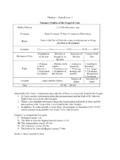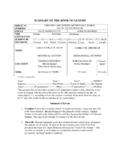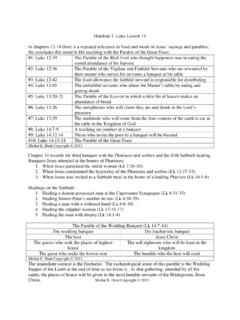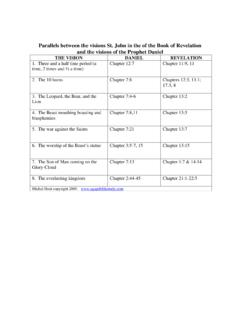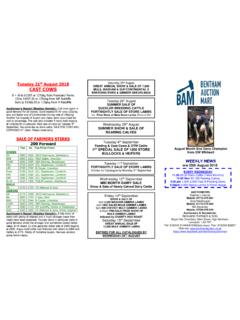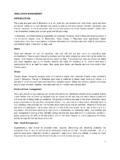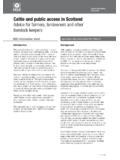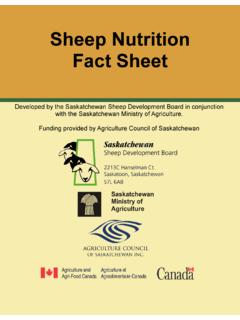Transcription of Handout 1: Leviticus Lesson 10 - Agape Bible Study
1 Handout 1: Leviticus Lesson 10 Parts I and II pertaining to eating of holy food (Lev 22:1-16). Introduction: they must sanctify it; I am Yahweh vs. 1-2 Part I: Laws for priests #1- #7 vs. 3-8 I, Yahweh, have sanctified them vs. 9 Part II: Laws for laity in a priest s household # 1- #7 vs. 9-13 Conclusion: I, Yahweh, have sanctified these offerings. vs. 14-16 Fourteen (seven times two) laws M. Hunt copyright 2010 Part I: Conditions that prevented eating holy food for the priests in verses 3-8: 1. Ritual uncleanness prevents contact with holy offerings 2. Contagious skin disease 3. Unclean discharge 4. Unclean through contact with a dead body 5. Seminal discharge 6. Touching an unclean reptile or unclean thing 7. Eating an animal found dead or an animal savaged by another animal Part II: Laity associated with a priest s household eating holy food in verses 10-13: 1.
2 A priest s guest may not eat holy food 2. A priest s hired laborer may not eat holy food 3. A priest s purchased slave may eat the holy food 4. A slave born in the priest s household may eat holy food 5. A priest s daughter who married a layman may not eat holy food 6. A priest s widowed, childless daughter living in his household may eat holy food 7. A priest s divorced, childless daughter living in his household may eat holy food The laws in parts III and IV concern priestly offerings of sacrificial animals: Introduction: Yahweh spoke to Moses and vs. 17-18a Part III: Unacceptable sacrificial animals Laws #1- #7 vs. 18b-25 Yahweh spoke to Moses and said vs. 26 Part IV: Offering animals for sacrifice Laws #1- #7 vs. 27-30; Conclusion: I, Yahweh, who make you , Yahweh vs.
3 31-33 Fourteen laws (seven times two) M. Hunt copyright 2010 Part III and IV: fourteen laws addressing sacrificial animals 1. Whole burnt offering without blemish 1. Newborn calf with mother seven days 2. Animals with defects not acceptable 2. Newborn lamb with mother seven days 3. Communion offerings unblemished 3. Newborn kid with mother seven days 4. No blind, injured, maimed or diseased animals are acceptable for sacrifice 4. Heifer and her calf not sacrificed on the same day 5. Free-will offering (nedavah) can be a bull or lamb with a slight defect 5. Ewe and her lamb not sacrificed on the same day 6. Animals with damaged testicles are not acceptable 6. Todah communion offering to be sacrificed in the acceptable way 7. Animals must be raised by covenant people and not from foreign lands 7.
4 Todah communion offering to be eaten in one day, not to be left over until morningM. Hunt copyright 2010 Handout 2: Leviticus Lesson 10 Prohibitions for Priests Prohibitions for Sacrificial Animals 1. Blindness (Lev 21:19) Blindness (Lev 22:22) 2. Disabled arm or leg (Lev 21:19, 20) Injured or maimed leg (Lev 22:22) 3. Ulcerous (Lev 22:4) Ulcerous (Lev 22:22) 4. Scabby (Lev 21:20) Scabby (Lev 22:22) 5. Deformed (Lev 21:19, 20) Deformed (Lev 22:23) 6. Damaged testicles (Lev 21:20) Damaged testicles (Lev 22:24) 7. Defective eyes (Lev 21:20) May not draw near the altar (Lev 21:17-18) Israelites may not bring near the altar (Lev 22:20, 24) M. Hunt copyright 2010 The divine command to keep the appointed seasons of Yahweh in Chapter 23 Introduction: Yahweh spoke to Moses and are my appointed times (mo ed) (Lev 23:1-2) The seventh day Sabbath obligation (Lev 23:3) These are appointed times (mo ed) of Yahweh, holy gatherings which you shall proclaim in their appointed seasons (Lev 22:4) Seven annual feasts: -Passover -Unleavened Bread -Firstfruits -Weeks (Pentecost) -Trumpets -Day of Atonement -Tabernacles (Lev 22:5-36) These are appointed times (mo ed) of Yahweh.
5 Recap on the feast of Tabernacles (Lev 22: 37-43) Conclusion: And Moses announced the appointed times (mo ed) of Yahweh to the sons of Israel. (Lev 22:44) The Interlinear Bible : Hebrew-English, vol. 1, pages 321-25; M. Hunt copyright 2010 The introduction to the liturgical calendar s appointed times in Leviticus 23:1-4 is laid out in a reverse chiastic pattern in the Hebrew text (Hebrew word order is a bit different from the English translation). A chiastic pattern emphasizes the importance of the passage. The X in the outline below marks the pivot point in the pattern: A-1: you will summon them B-1: the sacred assemblies (appointed times) of YHWH C-1: these are my solemn festivals (appointed times) D-1: six days E-1: you will work X.
6 But the seventh will be a day of complete rest, a day for the sacred assembly on which E-2: you do not work at all D-2: this is the (seventh day) Sabbath for YHWH C-2: these are YHWH s solemn festivals (appointed times) B-2: the sacred assemblies A-2: to which you will summon Israel on the appointed day (from Milgrim, Leviticus , page 1952). THE SEVEN SACRED ANNUAL FEASTS OF THE OLD COVENANT: The Feasts of Remembrance Yahweh said to Moses, Speak to the Israelites and say to them: These are my appointed feasts, the appointed feasts of Yahweh, which you are to proclaim as sacred assemblies (Lev 23:1-2).
7 Then never let anyone criticize you for what you eat or drink, or about observance of annual festivals, [..].. These are only a shadow of what was coming; the reality is the body of Christ (Col 2:16-17). * = Pilgrim feasts: Ex 23:14-17; 34:18-23; Dt 16:1-16; 2 Chr 8:13 Sacred Feast and Sacrifices Scripture References Old Testament/ Modern Time Old Testament Remembrance and New Testament Application PASSOVER (Pesach) Sacrifice of unblemished yearling lambs and kids, one for every 10 to 20 people in a group. Ex 12:1-4; Lev 23:5; Num 9:1-14; 28:16; Dt 16:1-3, 4-7; Mt 26:17; Mk 14:12-26; Jn 2:13; 11:55; 1 Cor 5:7; Heb 11:28 14th Abib (Nisan) March/April Old Testament: Signifying Israel s deliverance from death in the tenth plague. last legitimate Old Covenant Passover sacrifice (Lk 22:7-13).
8 *UNLEVENED BREAD (Hag Hamatzot). Seven day feast from the 15th -21st. On the 15th at sundown eating the meal of the Passover victim with family and friends; mandatory assembly on the 15th and 21st; mandatory sacrifices for 7 days = whole burnt offerings of 2 young bulls, a ram and 7 yearling lambs without blemish with cereal offerings; a goat for a sin offering; 2 lamb communion offerings; individual festival communion offerings each day eaten in the camp of God/Jerusalem. Ex 12:15-20; 39; 13:3-10; 23:15; 34:18; Lev 23:6-8; Num 28:17-25; Dt 16:3, 4, 8; 2 Chr 30:22-33; Mk 14:1, 12; Acts 12:3; 1 Cor 5:6-8 15th -21st Abib (Nisan) March/April 7 day feast Old Testament: Signified the sanctification of Israel by eating the Passover sacrifice in a sacred meal with unleavened bread.
9 For seven days eating bread with yeast (the symbol of sin) is forbidden. Remembering how Yahweh redeemed Israel out of Egypt. = The Last Supper/first Eucharistic sacrifice, Passion and Crucifixion (Mt 26:19-29; 57; 27:27; Mk 15:25; 33-39). FIRSTFRUITS (Yom Habikkurim) Presenting the first sheaf of the barley harvest; a burnt offering of a single unblemished male lamb with a grain offering and wine libation. Ex 23:19; 34:26; Lev 23:9-14; Dt 26:5, 9-10; Mt 28:1; Mk 16:1-2; Lk 24:1; Jn 1:20; Rom 8:23; 1 Cor 15:20-23 No date: on the day after the first Sabbath after Passover (Lev. 23:11); always on a Sunday (day later changed) Abib (Nisan) March/April Old Testament: Signified the resurrection of Israel as a free people. Recognizing the redemption of the first-born sons and God s bounty in the Promised Land.
10 Resurrection Sunday (Mt 28:1-8).*WEEKS (Shavuot/Hag ha-Shavuot; Pentecost in Greek = 50th day ; also known as Hag ha-Katzir = feast of the harvest ). Mandatory assembly and sacrifices: first fruits of the wheat harvest, burnt offering of 2 young bulls, a ram, 7 yearling lambs all with cereal offerings, goat as sin sacrifice, and the people s individual festival communion offerings. Ex 23:16; 34:22a; Lev 23:15-21; Num 28:26-31; Dt 16:9-12; 2 Chr 30:22-33; Acts 2:1-4; 20:16; 1 Cor 16:8 50 days after Firstfruits (as the ancients counted); always fell on a Sunday (day later changed) Sivan May/June Old Testament: Signified the origination of Israel as the covenant people. A festival of joy recalling the giving of the Law at Sinai 50 days after leaving Egypt; thankfulness for the Lord s blessings and birth of the Church.

